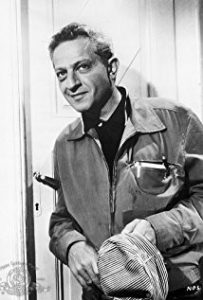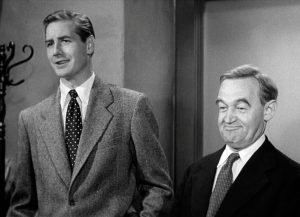Based on a book of photographs by the photographer Weegee along with a story written by Malvin Wald and Albert Maltz, 1948’s The Naked City brings New York City to life. This film was one of the first police dramas shot solely on the streets of New York. With voice-over narration by producer Mark Hellinger, this semi-documentary explores life surrounding the “Big Apple.” Its stunning panoramic views and wide-angle shots convey a claustrophobic city of eight million people, each with each their own story to tell. Events, good and bad, are happening simultaneously all over; yet life doesn’t stand still just because one can’t see it happening.

Jules Dassin, director of The Naked City
Director Jules Dassin wanted to direct this film in a documentary style primarily to convey “truth” – a truth that was lost because of the creation of the atomic bomb and the secrets that were created because of war. Post war, people were more cynical, mistrusting, and uncertain. No one knew what kind of misfortune would strike next. As audiences changed, the movie industry had to as well. Films evolved from films of love, emotions, and happy endings, to organized crime, femmes fatales, troubled protagonists, and less-happy endings. Through voice-over narration, common tropes of films noir, and the concept of a “staged documentary”, The Naked City represents the quest for truth by “asking a thousand questions to get one answer.”
Shortly after World War II ended, and the Cold War is just beginning, the United States was more paranoid and more suspicious than ever before. October 20, 1947 brought about an investigation into Communist infiltration in the American film industry. Actors, writers, and directors were investigated by the House Un-American Activities Committee (HUAC) and closely watched for any communist motives. Those refusing to cooperate with HUAC were blacklisted from Hollywood and many were unable to find other jobs.
Released in 1948, The Naked City follows a homicide detective Dan Muldoon (Barry Fitzgerald) and his young partner Jimmy Halloran (Don Taylor) as they pursue the murder of dress model who is linked to a gang of jewel thieves.
https://www.youtube.com/watch?v=p3WHT4HpsCo
The opening scene of The Naked City.
The opening scene is a rare instance of film breaking the fourth wall. With aerial views of NYC, Mark Hellinger describes the principal cast who will portray a story within real life. The murder mystery is of fictional content, but the thousand of New Yorkers are real, as are the “buildings in their naked stone.” As the day moves into night, we see New York asleep—as if the city is a living, breathing organism.
https://www.youtube.com/watch?v=nfH3aY-Qy6I
The setting of urban New York City is vital to The Naked City.
The cinematography used here brings about the rawness of true life; like a documentary, we see a montage of short clips framing both real characters and our fictional ones, depicting their thoughts, lives, desires, and troubles. Within this rawness comes the story of a murder investigation centered around Jean Dexter’s murder. Here we see the classic noir trope that leads the audience through each step of the investigation, through twists and turns, and through the ups and downs. A thousand questions are asked in order to find the truth of who killed Jean, and to penetrate the criminal world surrounding her life.
Composed by both Frank Skinner and Miklós Rózsa (who also composed music for Double Indemnity (1944) and The Killers (1946), the nondiegetic score related to both the time period and the setting. Rozsa’s calm, lighthearted melodies performed by a full orchestra surround the semi-documentary style lives of New Yorkers. In contrast, as the investigation picks up, the music does as well. The faster pace stimulates the audience and conveys the suspense meant to be felt.
While the Lt. Dan Muldoon (Barry Fitzgerald) guides the audience through the narrative, the real protagonist of this film is the city of New York. From the beginning when we see that this film will be a “staged documentary”–a fictional story within a true story portraying real people and places. Like a man in love with this city, Hellinger narrates every nook and cranny of NY, the incidental details, and the daily routine. The dark streets of NYC are full of dark alleys, police stations, playgrounds, bridges, apartments, and storefronts. In film noir, society is divided into light and dark, just like we see the city divided into light and dark. Furthermore, the mysterious murder of Jean Dexter serves as a dark side to the city. Yet, in the end, the killer is caught, and the world returns to normal. This is used as a metaphor for how life persists, despite war and chaos. By showing the continuity of life for others after Jean’s death, we can hope for the future. In a world ravaged by war, this was an important message to portray to audiences.

Halloran (Dan Taylor) and Muldoon (Barry Fitzgerald) as noir detectives.
Lt. Muldoon (right) is an Irish detective with a keen intuition. A friendly, honest, hardworking cop, he has recently been partnered with the inexperienced Jimmy Halloran (Don Taylor), an upright family man trying to find his way as the new guy. Together, Muldoon and Halloran interview Frank Niles (Howard Duff), Ruth Morrison (Dorothy Hart), and Dr. Stoneman (House Jameson) who lead the detectives to the names Philip Henderson and Willie Garzah (Ted de Corsia). Each character adds a new twist and eventually leads to the climatic manhunt .
Throughout there’s the question of who Philip Henderson is. Without giving that away, I would be remiss if I didn’t compare the motives of the antagonist Philip Henderson to those of Waldo Lydecker in the classic film noir, Laura (1944), minus the homosexual implications. Also reminiscent of both Laura and The Killers (1946), the classic femme fatale’s actions lead to trouble for both her and the other parties involved.
The Naked City led to a successful ABC television serial in the late ’50s and early ’60s, and in more recent times, we can see the influence the film and show both had on night-time television shows. TV shows such as Hill Street Blues, Law & Order, Blue Bloods, and Chicago P.D. follow the constant crimes occurring in large cities. Not only are audiences wanting to find out who the culprits are, they also want to follow the dramatic lives of the detectives, as they struggle and succeed, as they grow or remain stagnant, as they create relationships and lose them. Here we are able to truly see the genres of melodrama, film noir/neo noir, and others come together to create a world that draws audiences in.
The Naked City’s successes were not replicated by its makers, however. By 1951, director Jules Dassin and co-screenwriter Albert Maltz were both blacklisted after refusing to answer the committee’s questions regarding suspected Communist activities. After being blacklisted, Dassin moved to Europe and wouldn’t begin directing again until 1954. Maltz, in contrast, tried to return to Hollywood, but was only able to write three more films in his career before giving up writing.
The Naked City, though, had a long-reaching and long-lasting impact. Eight million people lived in NYC at the time and each of them had a story. Jules Dassin’s masterful combination of fact and fiction animates a story that both entertains and reassures. Hellinger’s voice-over narration brings organized life to such a chaotic city. A story of murder and the contrast between light and dark serve as classic noir tropes throughout the film. And a fictional story within real life is used to show how life continues after turmoil. While it has a straightforward and simplistic plot, The Naked City is able to show the complex beauty that encompasses New York City in the 1940s.

Trackbacks/Pingbacks